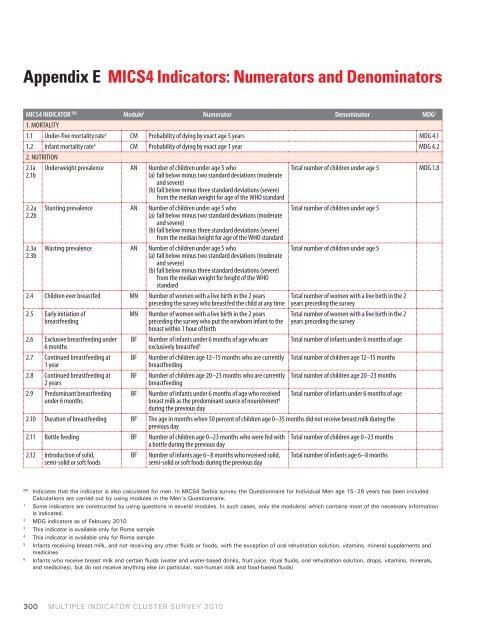Characteristics of Households - Childinfo.org
Characteristics of Households - Childinfo.org
Characteristics of Households - Childinfo.org
You also want an ePaper? Increase the reach of your titles
YUMPU automatically turns print PDFs into web optimized ePapers that Google loves.
Appendix E MICS4 Indicators: Numerators and DenominatorsMICS4 INDICATOR [M] Module 1 Numerator Denominator MDG 21. MORTALITY1.1 Under-five mortality rate 3 CM Probability <strong>of</strong> dying by exact age 5 years MDG 4.11.2 Infant mortality rate 4 CM Probability <strong>of</strong> dying by exact age 1 year MDG 4.22. NUTRITION2.1a2.1b2.2a2.2b2.3a2.3bUnderweight prevalence AN Number <strong>of</strong> children under age 5 who(a) fall below minus two standard deviations (moderateand severe)(b) fall below minus three standard deviations (severe)from the median weight for age <strong>of</strong> the WHO standardStunting prevalence AN Number <strong>of</strong> children under age 5 who(a) fall below minus two standard deviations (moderateand severe)(b) fall below minus three standard deviations (severe)from the median height for age <strong>of</strong> the WHO standardWasting prevalence AN Number <strong>of</strong> children under age 5 who(a) fall below minus two standard deviations (moderateand severe)(b) fall below minus three standard deviations (severe)from the median weight for height <strong>of</strong> the WHOstandard2.4 Children ever breastfed MN Number <strong>of</strong> women with a live birth in the 2 yearspreceding the survey who breastfed the child at any time2.5 Early initiation <strong>of</strong>breastfeeding2.6 Exclusive breastfeeding under6 months2.7 Continued breastfeeding at1 year2.8 Continued breastfeeding at2 years2.9 Predominant breastfeedingunder 6 monthsMNBFBFBFBFNumber <strong>of</strong> women with a live birth in the 2 yearspreceding the survey who put the newborn infant to thebreast within 1 hour <strong>of</strong> birthNumber <strong>of</strong> infants under 6 months <strong>of</strong> age who areexclusively breastfed 5Number <strong>of</strong> children age 12–15 months who are currentlybreastfeedingNumber <strong>of</strong> children age 20–23 months who are currentlybreastfeedingNumber <strong>of</strong> infants under 6 months <strong>of</strong> age who receivedbreast milk as the predominant source <strong>of</strong> nourishment 6during the previous dayTotal number <strong>of</strong> children under age 5 MDG 1.8Total number <strong>of</strong> children under age 5Total number <strong>of</strong> children under age 5Total number <strong>of</strong> women with a live birth in the 2years preceding the surveyTotal number <strong>of</strong> women with a live birth in the 2years preceding the surveyTotal number <strong>of</strong> infants under 6 months <strong>of</strong> ageTotal number <strong>of</strong> children age 12–15 monthsTotal number <strong>of</strong> children age 20–23 monthsTotal number <strong>of</strong> infants under 6 months <strong>of</strong> age2.10 Duration <strong>of</strong> breastfeeding BF The age in months when 50 percent <strong>of</strong> children age 0–35 months did not receive breast milk during theprevious day2.11 Bottle feeding BF Number <strong>of</strong> children age 0–23 months who were fed witha bottle during the previous dayTotal number <strong>of</strong> children age 0–23 months2.12 Introduction <strong>of</strong> solid,semi-solid or s<strong>of</strong>t foodsBFNumber <strong>of</strong> infants age 6–8 months who received solid,semi-solid or s<strong>of</strong>t foods during the previous dayTotal number <strong>of</strong> infants age 6–8 months[M]Indicates that the indicator is also calculated for men. In MICS4 Serbia survey the Questionnaire for Individual Men age 15–29 years has been included.Calculations are carried out by using modules in the Men’s Questionnaire.1Some indicators are constructed by using questions in several modules. In such cases, only the module(s) which contains most <strong>of</strong> the necessary informationis indicated.2MDG indicators as <strong>of</strong> February 20103This indicator is available only for Roma sample4This indicator is available only for Roma sample5Infants receiving breast milk, and not receiving any other fluids or foods, with the exception <strong>of</strong> oral rehydration solution, vitamins, mineral supplements andmedicines6Infants who receive breast milk and certain fluids (water and water-based drinks, fruit juice, ritual fluids, oral rehydration solution, drops, vitamins, minerals,and medicines), but do not receive anything else (in particular, non-human milk and food-based fluids)300MULTIPLE INDICATOR CLUSTER SURVEY 2010
















